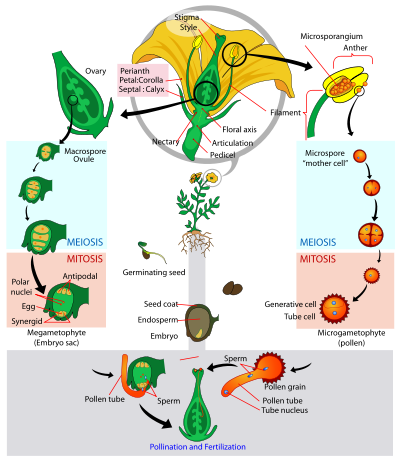Reproduction
Horseradish is an angiosperms meaning it is a flowering plant that fertilizes other flowers with pollen. Horseradish has a similar life cycle to most other angiosperms, having an alternation of generations, meaning both the gametophyte and sporophyte adults are multi-cellular organisms. the dominant generation is the sporophyte, which is the flowering plant.
Horseradish is a perennial, meaning that it flowers in May and June and will wither in the fall. The root remains in the ground and then grows again next year. The white flower of the plant distinguishes itself among other laves and foliage to attract pollinators such as bees or butterflies.
The life cycle starts with a mature flower. The anther in the center of the flower produces spores through meiosis. In meiosis, the diploid parent cell divides into four genetically different haploid daughter cells. These spores form groups of four, that are known as pollen grains. Horseradish has a pollen grain distinct from any other angiosperm. The pollen grains are then transferred by wind or other organisms to other Horseradish flowers to the ovary where they fuse making a diploid zygote. This formation produces a seed which will give rise to a new plant.
Horseradish can also reproduce with part of a root that is cut and placed in the ground. Before winter, the plant pushes its nutrients into the roots to grow next spring. a fairly small root has enough nutrients to grow a whole new plant with the same genetic make up as the mother root it came from.
Mariana Ruiz Wikimedia commons
